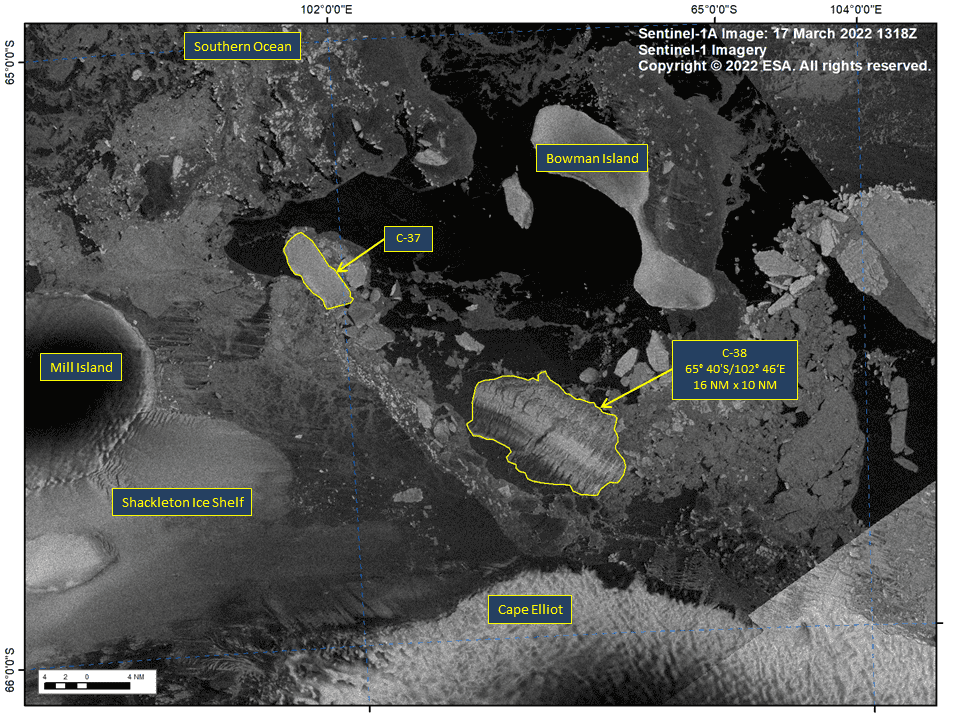A large ice shelf in East Antarctica has collapsed after days of record temperatures. The end of the Conger ice shelf, located on the East Antarctic coast near the Shackleton ice shelf, collapsed on March 15, based on satellite imagery. The shelf was around 1,200 square kilometers.

The US National Ice Center confirmed the bad news, posting a photo of the Conger ice shelf breaking off iceberg C-38 and collapsing in Antarctica. Catherine Walker, an Earth scientist at NASA, shared a GIF on Twitter that shows the shelf’s gradual recede leading up to March 14, and then the next image from March 16 shows it has fractured — a clear sign of what had happened.
Walker said despite the Conger ice shelf being relatively small, this is still one of the most significant collapse events since the early 2000s when the Larsen B ice shelf disintegrated. It won’t have any big effects in terms of sea-level rise but it’s a sign of what’s coming in terms of the climate crisis and the specific threats to Antarctica, she added.
Bertie Miles, a researcher at the University of Edinburgh, pointed out that the collapse “is the end of a long-term multi-decadal demise of the ice shelf,” with most of the loss happening between 1973 and 2000. Miles and other researchers have also shared on Twitter a GIF of the shelf’s collapse based on Copernicus’ Sentinel 1 satellite images.
The long term demise and eventual collapse of Conger ice shelf in East Antarctica 🇦🇶 as observed by @CopernicusEU #sentinel1 🛰️ pic.twitter.com/z78KGokTna
— Stef Lhermitte (@StefLhermitte) March 25, 2022
Ice shelves and climate change
Ice shelves are permanent floating sheets of ice that connect to a landmass. Most of them hug the coast of Antarctica but they can also form wherever ice flows from land into cold ocean waters. The northern coast of Canada’s Ellesmere Island, for example, has several well-known ice shelves, which play an important role in restraining inland ice.
As they already float in the ocean, these ice shelves don’t contribute directly to sea-level rise when they break up. But they do indirectly. Glaciers push on ice shelves but as the shelves come up against coastal features, they build pressure that slows glaciers. When a shelf collapses, that backpressure disappears, allowing glaciers to flow to the ocean.
Scientists have seen a series of unusual ice shelves collapsing on the Antarctic Peninsula during the last thirty years, which they attribute to warmer air and water temperatures. Air temperature in Antarctica has increased 3ºC since pre-industrial times, which is much higher than the 1.1º global average temperature increase.
The Thwaites glaciers, nicknamed the “doomsday glacier,” is probably the biggest concern of scientists at the moment. Cracks and fissures have opened up on top and underneath the glacier, which could lead to a fracture and collapse in three years or less. It has enough water on its own to raise sea levels worldwide by over half a meter.
Sea levels are already rising fast. The annual rate of increase has doubled from 1.4 millimeters to 3.6 millimeters between 2006 and 2015 and is accelerating. A few millimeters might not sound like much, but the loss of just a part of the Thwaites glacier would speed this up much further and increase the severity of storm surges.
There are many other big glaciers in Antarctica that are also retreating, thinning, and melting. But they are being held back by Thwaites, which acts like a cork and blocks their exit. If Thwaites indeed fall apart, scientists believe that the other glaciers would speed up, leading to the collapse of the entire ice sheet and a larger sea-level rise.
A warming trend
Researchers were surprised last week by unusually high temperatures in Antarctica and the Arctic. Concordia station, up on the Antarctic Plateau, hit a record of -11.8ºC last week – over 40ºC warmer than seasonal trends. At the same time, some stations near the north pole reached 30ºC above normal, with records broken in Norway.
Complete collapse of East Antarctica’s Conger Ice Shelf (~1200 sq. km) ~March 15, seen in combo of #Landsat and #MODIS imagery. Possible it hit its tipping point following the #Antarctic #AtmosphericRiver and heatwave too? #CongerIceShelf #Antarctica @helenafricker @icy_pete https://t.co/7dP5d6isvd pic.twitter.com/1wzmuOwdQn
— Catherine Colello Walker (@CapComCatWalk) March 24, 2022
The Antarctic continent as a whole was 4.8ºC warmer compared to a baseline temperature between 1979 and 2000. Researchers have linked this to strong weather systems over the Southern Ocean to the south of Australia and to an atmospheric river of moisture, trapping heat over Antarctica and causing warm surface temperatures.
The polar regions are being hit big time by climate change, with sea ice reducing fast. Last month, satellite images showed that sea ice around Antarctica reached a record low in four decades of observations. Ice-covered 750,000 square miles around the Antarctic coast, below the previous record of 815,000 from 2017, the data showed.


